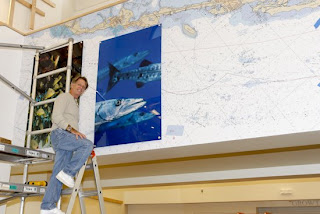














I was in the water again over the weekend shooting a motordrive sequence, 10-frames per second, for a Neosport wetsuits, to promote their triathelete suit. They wanted to run a flash sequence of a swimmer tracking across the top their website and asked me to get a competitive swimmer swimming through the frame. Beyond that, they left it up to me.
Booking the talent was the first project, and so I called Cody Wagner, now a freshman at Florida Atlantic University, and a very fit & athletic competitive swimmer. I knew he'd look great in the topside shots we needed of the suit, as well as being able to perform to freestyle sprint we needed for the underwater portion.
To mount the housing in place I used a very heavy tripod made of brass, so the wash of the swimmer passing right over the housing did not move anything. This tripod was designed for underwater use by Fenimore Johnson, in the early 1960s I would guess, and marketed under the Fenjohn brand. Jerry Greenberg gave it to me as a gift, and while it is way too heavy to travel with, it is terrific for use here at home in Key Largo.
I used a housed Canon 1DMKIII with a 14mm II lens with strobe fill from a Seacam Seaflash 150 at 25% power, and an Ikelte DS160 at about the same manual power setting. The low power output was necessary to keep up with the 10-frame-per-second motordrive burst, plus Cody was only a foot or so away from the dome at one point in his pass-over, so I did not want to blow out the skin tones with too much artificial light.
I used my Seacam housing with 9" superdome and swivel 45-degree viewfinder so I could view the image from the side, rather than having to lay down on the bottom of the pool and look upward, as I would have to do with a traditional viewfinder. However, next time I think I'll make it even easier and use my electronic viewfinder with remote monitor to view and trigger. That way I can be a couple of lanes away sitting in a floating chaise lounge, drinking pina coladas all the while.
I actually shot the sequence in RAW, even though I could have shot it as a medium sized JPEG and had plenty of resolution for the web use. But, I figured if they wanted to extract any single frame for print advertising we'd need RAW files. It is a testament to to the sophistication of the image-processing horsepower of my MKIII camera that it could capture files this big at this speed for a burst sufficient to nail the entire sequence.
For me, I usually shoot my 1DsMKIII underwater because I want those big 21 megapixel files, but having the exact same size camera able to fit in the housing, but with totally different specs means that I can use the 1DMKIII whenever I need ultra-quick motordrive sequencing or prefer the 1.3 cropped sensor rather than full frame. For me, this is an ideal combination.








































